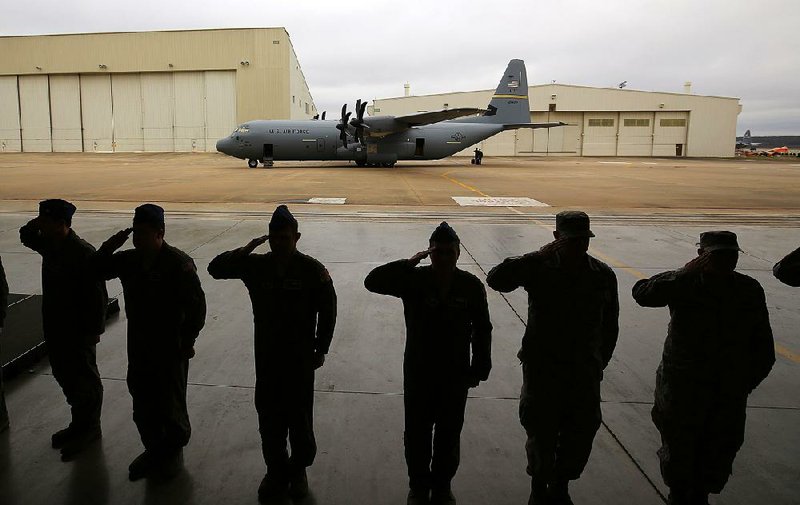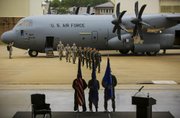The delivery of the last "Super Hercules" airplane to Little Rock Air Force Base on Monday marked the first time in 13 years that a squadron tasked with training pilots and crew for the hulking cargo planes has a full fleet.
Lt. Col. Jared Paslay, who commands the 62nd Airlift Squadron, said the base now has more capacity to train roughly 1,300 students a year who come through Jacksonville before they're assigned to their posts worldwide as pilots and crew on C-130s.
A ceremonial landing heralded the completion of the air base's transition to the newest model of the C-130, the so-called Hercules line that has a 60-year-old legacy as a plane known for the amount of cargo it can carry and variety of missions it can fly.
The phase-in of the C-130J, nicknamed the Super Hercules, at Little Rock was first planned 20 years ago, Paslay said. The base has more Super Hercules planes than any other in the world.
"I think it marks the completion of a 20-year promise, really, for a simulator and a C-130 fleet that can train the world's best air-lifters," Paslay said. "We've been kind of working with reduced resources since [2003], so it will be really nice to be at full capacity."
The Super Hercules flies farther, faster and higher than its predecessors and requires less space to take off and land. The model flown to Jacksonville on Monday can hold up to 23 tons of cargo, including helicopters and six-wheeled armored vehicles, and has space to fit 128 combat troops or 92 paratroopers.
Aside from panes above its nose, the nearly 133-foot-long gray airplane with a 132½-foot wingspan is windowless. A ramp at the rear lowers to load and release the cargo -- anything from airmen, parachutists or food to ammunition, gasoline or vehicles.
New technology has made the plane's navigator and engineer obsolete, reducing the onboard staff to two pilots and one person responsible for the cargo, Paslay said.
C-130s, the oldest continuously produced military aircraft in history, can be configured for combat delivery, aerial and ground refueling, and electronic warfare, among other uses, according to Lockheed Martin, the plane's producer.
Maj. Gen. James Hecker, commander of the 19th Air Force, flew the plane from Greenville, S.C., with help from co-pilots Maj. David Pearce and Maj. Gordon White.
"I think you mentioned I was aided by the crew," said Hecker, who had only flown the C-130 three times. "They pretty much carried me."
Staff Sgt. Joshua Shields accepted the key to the airplane, which was the 368th J model Lockheed Martin produced, Hecker said.
Lockheed Martin delivered the first C-130, or Hercules, in 1956 after the Air Force recognized a need to "take all of the aspects -- passengers, cargo, you name it, airdrop -- and combine it into one airplane" when crossing the 89th parallel during the Korean War, Hecker said.
More than 2,500 C-130s have been manufactured, and they are spread across more than 70 nations, Hecker said.
No air base in the world has more Super Hercules aircraft than Little Rock, which has 42 -- 14 assigned to the 62nd Squadron, Hecker said. Counting the Arkansas Air National Guard's Little Rock wing, the number of C-130s is 61, Hecker said.
Little Rock Air Force Base, also home to C-130 simulators, trains operators of the planes not only for the Air Force but for the U.S. Coast Guard and U.S. Department of Defense. Partnerships with allied nations send Japanese, Iraqis, Afghans and others to the base for training.
"I think of us as stewarding the heart of tactical airlift for the Air Force," said Paslay, who has commanded the 62nd Squadron for a month but has been stationed at the base for more than a year. "We're going to pretty much have a say in the majority of C-130 personnel in the Air Force and also in our international partners' [forces]."
The 62nd Air Squadron, which only handles C-130s, is staffed by 105 airmen. Training for students in Little Rock can span a few months to half a year.
"When they leave here, they should be fully qualified -- if they do a full course -- to do assault procedures, tactical low-level, night-vision goggles, airdrop and airlift," Paslay said. "Students who graduate here could find themselves in a war zone in a couple of months."
Lockheed Martin has manufactured two versions of the C-130J, one shorter in length and with less cargo capacity. The plane delivered Monday is considered the "stretch" version. Of the 14 in Paslay's squadron, about half are the stretch model, he said.
Lockheed will continue producing the Super Hercules for the federal government until at least 2020 through a $5.3 billion contract signed in 2015, a company official said.
Larry Gallogly, sales director of Lockheed Martin's air mobility programs, said the company plans to develop more variations of the C-130J and increase the types of missions it can fly.
"We will depend on our current operators, including the Little Rock team, to help us define the [Super Hercules'] present and future -- their insights and support have been key to the ongoing relevancy and evolution of the C-130 Hercules," Gallogly said by email. "We plan to manufacture the C-130J as long as needed to meet our customers' needs."
Metro on 02/28/2017


